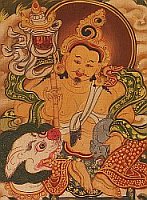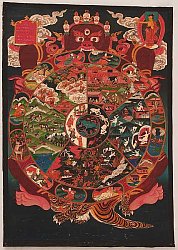| < Prev | Next > |
|---|
 Religious in origin, thangkas are scrolls from tantric Buddhism, which has played a prominent role in Tibet. Most of the bordered paintings made from expensive materials are valuable resources for the Buddhists in gaining them higher levels of recognition. They are simultaneously, however, the highest forms of religious art in Buddhism.
Religious in origin, thangkas are scrolls from tantric Buddhism, which has played a prominent role in Tibet. Most of the bordered paintings made from expensive materials are valuable resources for the Buddhists in gaining them higher levels of recognition. They are simultaneously, however, the highest forms of religious art in Buddhism.
Historical Origins of Thangkas
Historically the beginnings of thangka art are traced far back before the Christian Era. Buddhist deities or scenes from the divine teachings of truth are presented in rich detail and integrated with Buddhist symbolism.
The development of thangka art began most likely after the death of the Buddha Sakyamuni (circa 563-483 BCE), who founded Buddhism. It was not until the 7th century AD, however, before Buddhism spread throughout the Himalayan region and fragmented into different religious orders. Thus the following thangka art genres developed from different traditions in Kashmir, Nepal, China and Central Asia.
Tibetan Thangkas
The independent Tibetan genre of Art first came to form 1000 years later, which exists in 3 functionally different versions:
Thangkas for Teaching and Upbringing
 Wandering monks carried these thangkas with them, to instill the rural populations in religious as well as dogmatic and historical teachings. For the most part, the scrolls depict high ranking Buddhist figures and scenes from their lives or they illustrate the family trees of abbots.
Wandering monks carried these thangkas with them, to instill the rural populations in religious as well as dogmatic and historical teachings. For the most part, the scrolls depict high ranking Buddhist figures and scenes from their lives or they illustrate the family trees of abbots.
A common depiction is the Wheel of Life (Bhavacakra) that strongly symbolizes the cycle rebirths. The most important reoccurring theme in these types of thangkas is of course the Buddha himself and events from his life.
Thangkas as Consecration- and Votive Gifts
 Thangkas of this group generally portray the deities, to whom believers present their respective concerns, which are often accompanied by visual dedications on behalf of an ill person, a plea for the healing, or sometimes a plea for the fortunate rebirth of a deceased. These Thangkas are presented as gifts to monasteries, which is considered a deserving deed on part of the purchasers as well as the painters.
Thangkas of this group generally portray the deities, to whom believers present their respective concerns, which are often accompanied by visual dedications on behalf of an ill person, a plea for the healing, or sometimes a plea for the fortunate rebirth of a deceased. These Thangkas are presented as gifts to monasteries, which is considered a deserving deed on part of the purchasers as well as the painters.
Thangkas for Meditation Purposes
Meditation-Thangkas are the largest group of thangkas, dating back to the yoga-tantric practices. These thangkas aid in visualizing the deities, one of the many forms of meditation. The function of the thangkas is not easily determined from the visual content depicted since it features content matter contemplated on purely spiritual and deep psychological levels.
Forms of Thangkas
 Over centuries, the thangkas broke away from this original standard functions described above and performed various functions in temples, home altars and processions. From an artistic point of view, Tibetan thangkas are roughly simplified into 2 forms: the bris-than, which are watercolors painted on canvas, and the gos-than, which are woven in silk, embroidered or sometimes also sewn together.
Over centuries, the thangkas broke away from this original standard functions described above and performed various functions in temples, home altars and processions. From an artistic point of view, Tibetan thangkas are roughly simplified into 2 forms: the bris-than, which are watercolors painted on canvas, and the gos-than, which are woven in silk, embroidered or sometimes also sewn together.
While many thangkas feature color rich imagery, there are also stylized thangkas that feature different black, red or gold backgrounds. Another special form of thangkas consists of wood blocks and wood block prints on paper as well as on canvas.
Often wooden posts are fed into the top and bottom edges of the thangkas, which aids not only in hanging but also in the rolling of the scroll. Some thangkas are also partly shrouded by a covering sheet that is fastened by ties. Both the visual imagery as well as the cloth-material frame and other accessories employ predominantly powerful, bright and visually emotional and effective colors, giving the thangkas a noble and expensive appearance.
How Thangkas are Made
 When thangkas still served exclusively religious purposes, they were painted mostly in cloisters. With the beginning of tourism in the Himalayas starting around the 1960s, this changed. Painting schools and studios were established which made cheap tourist thangkas but also high-quality art for the discriminating collector. Such a studio typically consist of one master and several apprentices.
When thangkas still served exclusively religious purposes, they were painted mostly in cloisters. With the beginning of tourism in the Himalayas starting around the 1960s, this changed. Painting schools and studios were established which made cheap tourist thangkas but also high-quality art for the discriminating collector. Such a studio typically consist of one master and several apprentices.
Apart from these private and commercially motivated studios one can find painting schools managed and sponsored by public or private non-profit organizations. These assure the training of young people on a high level and the continuation of an old tradition and high craftsmanship independent from the laws of the tourist market. And besides, such initiatives create workplaces for young people.
The Making in Detail
Most thangkas are applied on a cotton canvas. At the beginning the canvas is treated with a certain mixture - a typical work for the youngest among the apprentices. After drying the canvas, the outline drawing is applied by the help of an iconographic template. Thangkas are iconographic works, meaning that all images are based on repeating patterns. Thus the artistic freedom of the painter is minimal, and is limited to the combination of colors. What counts is the quality of the work. Painting thangkas is not considered an art in the sense of the idea of creativity as it was dominant in Western civilizations during the 20th century, but rather a handicraft on a very high level. Therefore you will not find any thangkas with name signatures or name references to the painter.
The templates either stem from copies from the past, from books or they were drawn by the master based on old iconographic patterns with minor individual variations.
Next the backgrounds like the sky or the earth are applied. After that the details are added by and by. The faces of the Buddha or other gods and goddesses are considered the most difficult and demanding parts of the work. These are added by the master at the end. After an old belief the thangka receives its "life" with the painting of the faces.
The colors are made out of minerals and vegetables. More ingredients like glue or char coal are required. Gold plays a special role. It is used only for thangkas of high quality. Real gold leafs are used, which are pressed into powder. The final product is a shining, brilliant gold color. The manufacturing of these gold colors has for decades and centuries been a speciaity of the Newari goldsmiths in Nepal. Even the Tibetans have always imported the gold powder colors from the Newari.
In recent years, the old colors made of minerals and plants are now more and more replaced by modern painting colors. For this topic see a video on our web site about Thangka Painting.
Collector Tips
 Art lovers and collectors can divide thangkas basically into three different categories:
Art lovers and collectors can divide thangkas basically into three different categories:
- Thangkas older than 100 years.
- High quality thangkas created in the 20th century.
- Cheap thangkas made for the tourist market.
Thangkas older than 100 years were and are not allowed to be exported out of Nepal, which can be considered the most important country for Tibetan thangka painting. In terms of quality, old thangkas are not necessarily the better thangkas. In former times there were good and poor handicraftsmen just as today, or the quality standard was limited due to what the commissioner of a thangka was willing or could afford to pay. If you are familiar with the subject, you can easily verify this fact by visits to museums of East Asian Art.
I also want to mention that a large part of "old" thangkas and 'old' Tibetan bronzes offered in the Western art market, is in my personal and humble opinion of rather recent nature. Nepalese handicraft people are great masters in making things "old". (Maybe one should really speak of artists in such cases.)
A thangka of highest quality created in the 20th century can be a real masterwork, which required several months of work. But how can a non-expert discern a good from a poor thangka? Of course, by training your senses. But there are also a few good indications for inexperienced newbies:
- The level of elaborateness and details of the painting
- The harmony of the color combinations
- The use and quality of color gradations
- The price
- The use of real gold
- The quality of the cloth
 Pay attention to how elaborately a thangka was painted. Pay especially attention to the faces and the precise details of the feet and hands. These details are made sloppy on cheap thangkas like the depiction of people on some Japanese Hiroshige woodblock prints of lesser quality.
Pay attention to how elaborately a thangka was painted. Pay especially attention to the faces and the precise details of the feet and hands. These details are made sloppy on cheap thangkas like the depiction of people on some Japanese Hiroshige woodblock prints of lesser quality.
Take your time for comparisons, and by and by you will get an eye for good quality. Take also a look at the depiction of the smaller gods and goddesses outside of the center of the thangka.
For a top quality thangka you should accept a price of ca. $ 1,000 and more. Cheap tourist thangkas are available in Nepal for as little as $ 20.
As the use of real gold is by nature expensive, it is used only for the best thangkas. But beware, cheap thangkas may also be painted with golden colors, but this is a golden color not from real gold. These color pigments do not have the brilliance and shining of the real gold colors. They are easily recognizable. As far as I remember, the dealers in Nepal used the terms "gold colors" and "golden colors" to fool the tourists without offending the experts.
Provided a thangka still has its original cloth, it too can be an indicator for quality. Lush brocade cloths usually (but not always vice versa) decorate a thangka of better quality.
Dieter Wanczura







